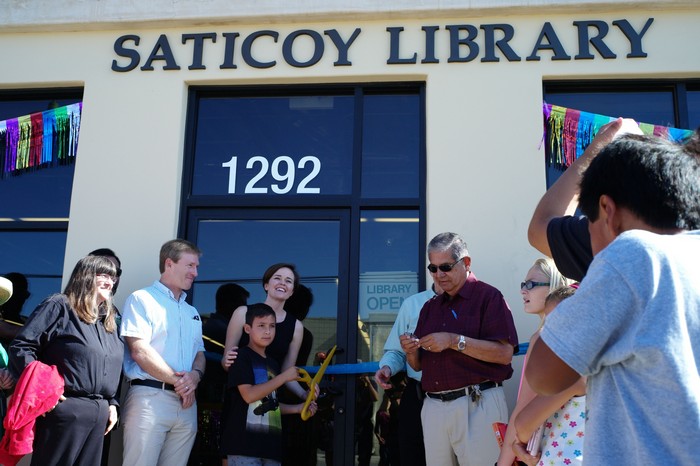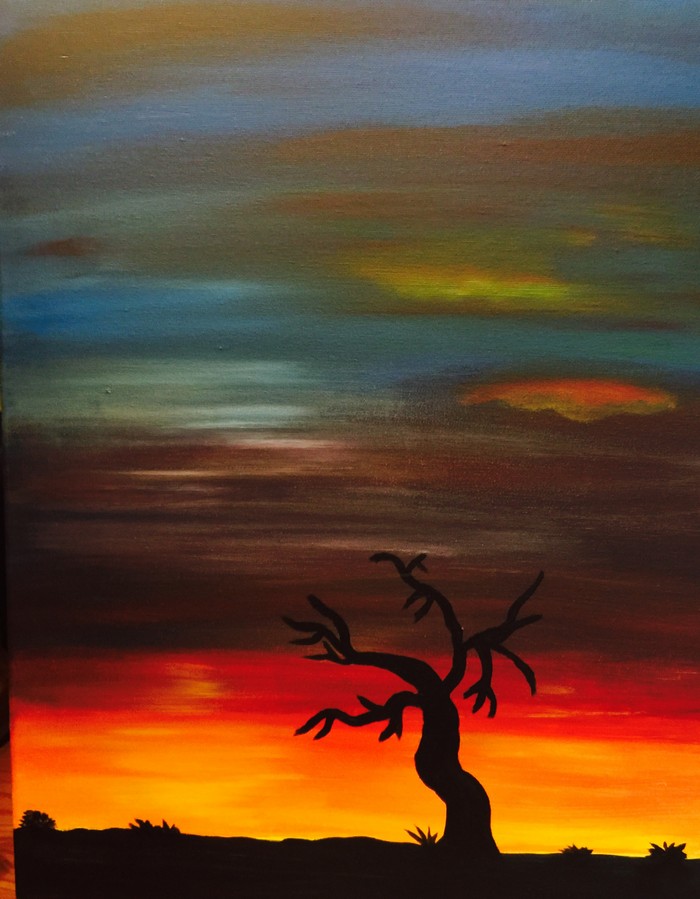 On occasion we will be featuring the art work of Ventura Breeze staff, this acrylic is by Breezy Gledhill Senior Account Executive. You can only view her work in her living room for private showing she is very exclusive.
On occasion we will be featuring the art work of Ventura Breeze staff, this acrylic is by Breezy Gledhill Senior Account Executive. You can only view her work in her living room for private showing she is very exclusive.
All posts by admin
Christina Altfeld’s, “From here to Zen” exhibit at the Harbor Village Gallery
Artist Christina Altfeld’s, “From here to Zen”, will be featured at the Harbor Village Gallery October 3rd through November 1st. With an opening reception on Saturday Oct.3 from 4-7pm.
Christina marries her love of nature with her desire to find the calm in daily life. She has been focusing on her passion of printmaking and is combining it here, with her lifelong love of photography. With this new exhibit, she explores the theme of peace and calm through her art.
Originally from Sweden and after 15 years of living on the island of Maui, Christina now calls Ventura her new paradise of home.
Jon Ng “Cloudscapes” at Vita Art Center
 Jon Ng “Cloudscapes” can be seen at Vita Art Center, located in the Bell Arts Factory 432 N. Ventura Ave.
Jon Ng “Cloudscapes” can be seen at Vita Art Center, located in the Bell Arts Factory 432 N. Ventura Ave.
Opening Reception: Friday, October 2 from 6-9 p.m. exhibit October 2 – 26
Jon Ng’s work maintains a bridge between classical still-life and figurative painting and contemporary art. One feels the strong presence of a 600 year old tradition in the midst of having a 21st. century visual experience. Mr. Ng paints a certain reality; yet evokes a sense of solitude, displacement and transformation. His work is as simple and beautiful as it is rife with human and earthly complexities.
Gallery hours: M-F 10-4 pm Sat. & Sun. by appointment www.vitaartcenter.com
Nikos Valance appointed to Ventura Port District Board
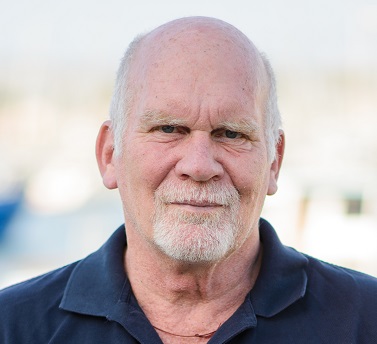 Valance is also a board member of the Ventura Hillsides Conservancy
Valance is also a board member of the Ventura Hillsides Conservancy
Photo by Kyle Sallee
The Ventura City Council has appointed Nikos Valance, a local attorney, economist and lecturer at California State University Channel Islands, to his first four-year term on the Ventura Port District Board of Port Commissioners.
Valance, a New York native, also is a board member of the Ventura Hillsides Conservancy and he previously served for four years as member of the Manhattan Community Board in New York.
“In New York I was always very active in civic affairs and community projects. Once I settled in Ventura, I wanted to be more active and also give to the community,” he said. “I’m really thrilled about living in Ventura and enthusiastic about the potential of the Harbor.”
Valance would like to see the City of Ventura and the Ventura Harbor grow as tourist and vacation destinations, and work together more closely. He’d also like to see more art events and activities at Ventura Harbor, such as artists painting outdoors and a theater for plays. “It would enhance the whole ambiance at the Harbor.”
An attorney and economist, Valance is excited to be teaching economics for the Martin V. Smith School of Business and Economics at California State University Channel Islands.
Valance has several areas of interest and specialties in his work, including: business and human rights; domestic and international water policy; local and regional sustainable economic development; systems of local and regional governance development; natural resource development; and the rights of indigenous people domestically and internationally.
The Ventura Port District is committed to providing quality, marine-oriented, visitor- serving assets and a safe environment for the public. The Ventura Harbor is a premier recreational harbor in Ventura County offering a variety of amenities for boater enthusiasts and visitors, including easy access to the Channel Islands, recreational fishing activities, boatyards, fuel docks, tours, rentals, cruises, vibrant yacht clubs and a new public launch ramp. Ventura Harbor has five marinas with 1,500 boat slips. Visit www.venturaharbor.com to learn more and view the Port District board agendas. The Board of Port Commissioners conducts regular meetings that are open to the public on the second Wednesday starting at noon and the fourth Wednesday starting at 7 p.m. each month.
Vol. 8, No. 26 – September 30 – October 13, 2015 – Professor Scamp
• Herman Bennett Foundation’s Haunted Mansion Dinner, Ghost Tour & Magic Fundraiser! October 30th at the historic Bard Mansion on the Port Hueneme Naval Base benefitting the Foundation’s spay & neuter programs across Ventura County.
Help control the local animal population and prevent the needless deaths of cats and dogs.
All tickets sales are a tax-deductible donation.
Tickets available by phone at 445-7171.
Visit hermanbennettfoundation.org for more information.
• I received the following from Mindy Benezra:
“My dear friend Scamp:
Regarding the photo of the Shih Tzu puppies in the last issue of the Breeze.
The truth is, a litter of 8-9 Shih Tzu puppies are cute, but not really, and they are quite unnecessary as is every litter of puppies until we fix the problem of overpopulation of pets.
There are plenty of Shih Tzu’s and Shih Tzu mixes who are homeless and already born. Why do we want to make more of something we already have too many of?
Statistics state that 25% of purebred dogs end up in shelters, so 2-3 of these pups are doomed to homelessness.
Tens of thousands of healthy adoptable pets are euthanized each year in California alone .
In this country 8-10 million pets enter shelters annually and less than half ever make it out.
If kids read the Breeze or even look at the pictures, it is the wrong message to send.
No, puppies aren’t cute… There are too many homeless dogs and cats already!
People should spay and neuter their pets, support their local shelters and rescues, they should not buy from breeders, they encourage adoption. Once the shelters are clear of homeless dogs, we can make more Shih Tzu puppies and then they will be cute.
The only solution is to teach our kids, they are the key to fixing this problem: the next generation, the ones who have learned about the tragedy of our homeless pets, and who are responsible and compassionate enough to be part of the solution( Spay and neuter) not the problem (more puppies)…
Thank you for everything that you have done to help CABODOGZ and other homeless pets find their way home.
Mindy Benezra
CABODOGZ
Ventura Hwy Luxury Boarding for Dogs”
Mindy: I appreciate what you are saying, and all you do to save dog’s lives which is why I always have dogs to adopt but they still are cute. Scamp
• “The Blessing of the Animals” Saturday October 3, 11am
All pets are welcome for the blessing. Charles Carroll Funeral Home
15 Teloma Dr., Ventura. See the ad in this issue.
• The Humane Society has ranked California number one for six straight years on its list of fifty states for laws and policies that relate to wildlife, farm livestock, pets, and animal fighting. Regulations, legislation, and ballot measures have been passed by the state of California in order to improve the lives of our animals for many years. Some of these include bans on dog fighting and cock fighting, hunting of bears with dogs, poisonous lead bullets for hunting, and shortening dairy cow tails (I hope my tail is included in this).
There are horrible people who don’t like these laws because they will lose business. Maybe dogs should have events where people try to kill each other and we could use the money to build no-kill shelters.
But I think it is something to take great pride in that our state is known as the most animal friendly. Be sure to pet a dog today.

Archie the therapy dog has gone to doggie heaven where everyone is wagging their tails.
• It is with a deep and heavy sadness that Casa Pacifica has announced the passing of its beautiful Newfoundland and original therapy dog, Archibald Razz-M-Tazz – more famously known as “Archie the Therapy Dog.” Archie, who turned 10 years old in May, was the agency’s “gentle giant,” a great healer who brought his peaceful, calming presence, comfort, and love over the last decade to nearly 4,000 children on Casa Pacifica’s campus – children placed in the emergency shelter, residential treatment center, or attending the nonpublic school. He possessed an insightful intuition that seemed to tell him when a child needed his extra attention and gentle presence. He demonstrated an endless patience with children pulling his tail, poking in his nose and ears, tugging his fur, and lounging up against, or atop, his enormous body. He would sit for long periods of time with a child, letting them read to him or cry into his fur. He loved to run and chase behind the youth in Casa Pacifica’s quad, sometimes stealing their football or soccer balls and popping them in his teeth, or swimming and playing with the children in the pool. The children loved it, and loved him. Archie was certified as a therapy dog and in water rescue.
Archie was the biggest dog that I ever saw.
• I want to thank East Ventura Animal Hospital for being a new sponsor in the Breeze. I will be asking them questions about animal care in future issues.
I asked my veterinarian friends at Ohana Pet Hospital these questions.
Q Is it true that my mouth is cleaner than my human friends?
A That is actually a myth. The truth is that your mouth is overflowing with bacteria but most of those nasty germs are species specific so it won’t affect your human friends when you go in for the sloppy, wet smooch. Always be sure to keep your shots current to avoid problems. – Dr. Jennifer Kelly, DVM Thanks I love smoochy kisses.
Q My human is a chocoholic but he never wants to share with me. Isn’t that mean?
A No! You should actually say, “thank you” because chocolate can make you very sick or
even kill you. Humans might love it but for you, chocolate can be poison. If one of your dog friends eats it, his vet should be called immediately. The vet will want to know how big your friend is and how much chocolate was eaten. Depending on the answers to those questions, your friend might need to make a trip to the vet. Dr. Jennifer Kelly, DVM Okay I will stick to strawberry Sundays
How local students have given themselves the best chance to succeed in the new school year
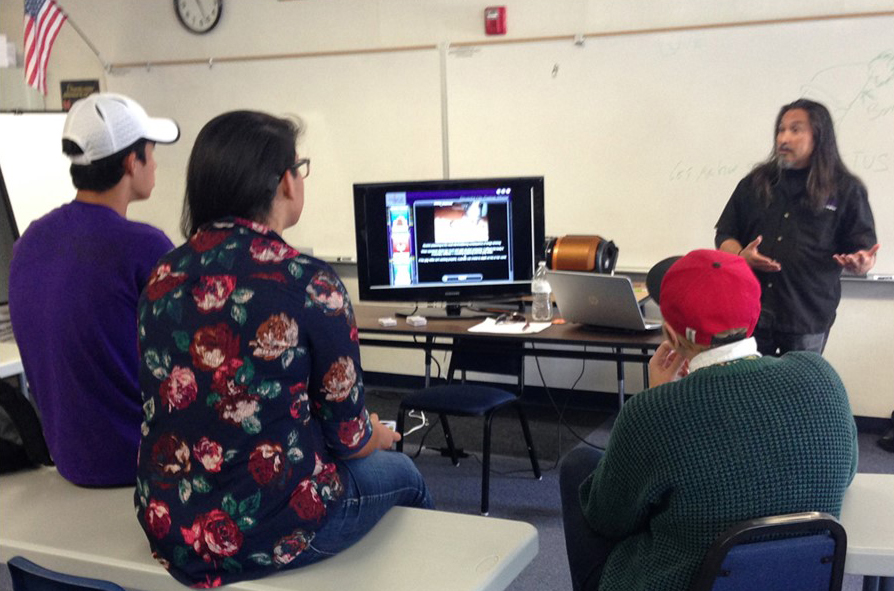 Straight Up staff member Roland Roberts leads an interactive activity/discussion abo with students at El Camino High School.
Straight Up staff member Roland Roberts leads an interactive activity/discussion abo with students at El Camino High School.
For the past few weeks, we’ve watched as Ventura students, from middle school to college, have been returning to their studies. With the new academic year, young people face new challenges. Some have found ways to find fresh starts, and prepared themselves so that they have the best chance to excel, and to avoid the many pitfalls they can face.
Some educators have helped with the transition, scheduling icebreaker and team building sessions during the summer, so that students can meet and interact with their peers.
Straight Up, a County-based youth development program that works with young people, has often been involved, scheduling activities and discussions to encourage young people to share, work together and gain confidence.
“Being able to open up channels of communication among young people is important,” says Straight Up’s Executive Director Katherine Kasmir.
One student who feels prepared is Nathan Silva, 11, of Ventura, who has started middle school. He recently participated in a Straight Up advocacy workshop, which armed him with information about the dangers of tobacco and other substances.
Does Nathan feel ready for the new school year? “The new grade is more competitive and I want that,” he says. “I want to push myself harder to achieve my goals and get a lot more done.”
Another young person facing a lot of change is Chris, 18 and from Ventura, who is on the road back from a struggle with drug and alcohol use.
“I was a ‘varsity Christian’ – I didn’t drink or smoke weed. But then in my senior year, I was in a relationship that ended badly, and I spiraled into destructive behavior.”
He has been open about his experiences, and has spoken to groups about his struggles, which helps his own resolve to stay sober, productive, and focused.
“I have never had a more solid sense of belonging and hope,” Chris says. “This is what I was meant for. “
Do either Nathan or Chris consider themselves role models?
“Yes and no,” says Chris. “Because of my experiences, I can relate and sympathize and get a deeper understanding of others – and hope they can find a good path, as I have done.”
Nathan does think he can be a positive influence on others. “I can warn other people who are making bad decisions not to make them and that there will be consequences,” he says. “I show people they should be nice and respect others.”
Vol. 8, No. 26 – September 30 – October 13, 2015 – Scamp Club
 Hi: I’m Luigi Maltese, I’m 6 and also known as Napoleon. I’m a therapy dog, we come in all shapes and sizes. I speaks Italian and love yumi-yumies and running in circles like cats do.
Hi: I’m Luigi Maltese, I’m 6 and also known as Napoleon. I’m a therapy dog, we come in all shapes and sizes. I speaks Italian and love yumi-yumies and running in circles like cats do.
Vol. 8, No. 26 – September 30 – October 13, 2015 – Forever Homes Wanted
 Breckan would like to remind everyone, “Adopt. Don’t Shop!” This handsome Silver Marten arrived at Ventura County Animal Services on Easter Day along with 12 other babies who were too young to be separated from their mother. Devoted VCAS volunteers took these babies into foster and bottle fed them morning and night until they were strong enough to eat on their own. Breckan is now neutered and ready for his forever home. This engaging bunny loves his daily salad and will do just about anything for a nibble of apple or a raisin. To meet this sweet bunny and learn how fostering saves lives, visit VCAS at 600 Aviation Drive in Camarillo and ask for ID number A618667. For information about offsite rabbit adoptions, bunny nail trims, and compatibility dates, please visit www.facebook.com/VCASBunnyBrigade.
Breckan would like to remind everyone, “Adopt. Don’t Shop!” This handsome Silver Marten arrived at Ventura County Animal Services on Easter Day along with 12 other babies who were too young to be separated from their mother. Devoted VCAS volunteers took these babies into foster and bottle fed them morning and night until they were strong enough to eat on their own. Breckan is now neutered and ready for his forever home. This engaging bunny loves his daily salad and will do just about anything for a nibble of apple or a raisin. To meet this sweet bunny and learn how fostering saves lives, visit VCAS at 600 Aviation Drive in Camarillo and ask for ID number A618667. For information about offsite rabbit adoptions, bunny nail trims, and compatibility dates, please visit www.facebook.com/VCASBunnyBrigade.
 Hi: I’m Katie a shy 3 1/2 year old Chihuahua X who is in need of a new home. I was originally found as stray and when my owners couldn’t be found, they decided to keep me. Now they’ve decided I have to go, but I’m lucky to have a sponsor so I could come into the C.A.R.L. program.
Hi: I’m Katie a shy 3 1/2 year old Chihuahua X who is in need of a new home. I was originally found as stray and when my owners couldn’t be found, they decided to keep me. Now they’ve decided I have to go, but I’m lucky to have a sponsor so I could come into the C.A.R.L. program.
I’m not overly active, enjoy a comfy lap to sit in and laying out in the sun. I’m good with other small dogs, but I don’t care for cats. Although I lived with children and did okay, I’m still getting used to my new surroundings and if I get afraid I try to defend myself, so for this reason I’d do best in a home without small children. I walk well on a leash so we can go on leisurely walks together. I also come when called, so hopefully you’ll be calling my name soon.
Once a hardware store now a library
New beautiful, state-of-the-art library in Saticoy.
On September 26 the Ventura County Library system held a Grand Opening celebration for the new Saticoy Library located at 1292 Los Angeles Ave. right off of Wells Dr. This is the location of the old Saticoy Hardware building which had remained vacant for many years.
The Saticoy Library has activities five days a week, special events every week, a teen group, and an involved and enthusiastic staff. The grand opening events were planned by Library Tech Jane Middleton.
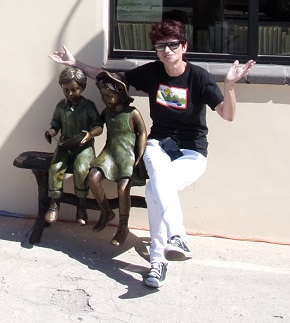
The large, beautiful, state-of-the-art library has 12 public computers, new furniture, all-new faster internet, a children’s’ section and long counters by the front windows with plugs-ins for personal devices.
Among those present for the ribbon cutting were Ventura County Library Director Jackie Griffin, Ventura Deputy Mayor Erik Nasarenko, Library Deputy Director Sara Roberts watching Joshua Canales prepare to cut the ribbon. Ventura County Supervisor Steve Bennett was also present but didn’t make the photo.
The Library can be reached at 671-5148.
Photo by Daniel Ingram
Ventura County 4-H launches “Trick Or Treat So Others Can Eat”
Ventura County 4-H Club and FOOD Share, the non-profit organization devoted to feeding those in need in our community, are inviting all youth in Ventura County to join their annual October Youth-Led Food Drive for the month of October through November 13th. “Trick Or Treat So Others Can Eat” (TOTSOCE) is returning for its 18th year, and is open to all youth in Ventura County. Over the years, Ventura County youth have raised thousands of pounds of food donations for FOOD Share through this fun seasonal campaign. This year, youth collectors are also searching for business sponsors who may be interested in matching funds for pounds collected.
TOTSOCE is simply a youth-led canned food drive with all donations directly benefiting individuals and families in need in Ventura County. To register your youth group, school, team or club, please contact [email protected] or contact the Ventura County 4-H office or FOOD Share for more information. Collection starter kits are available through email registration or 4-H http://ceventura.ucanr.edu
Collection should take place between 10/1 and 11/13 and all food donations should be at FOOD Share by 4:00 PM Friday 11/13.

